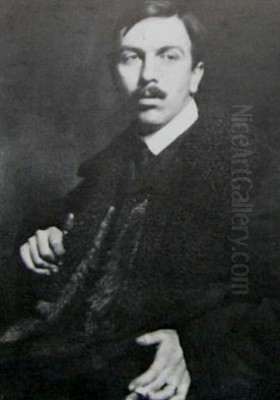
Alson Skinner Clark (March 25, 1876 – March 23, 1949) stands as a significant figure in American Impressionism, renowned for his vibrant landscapes, compelling architectural scenes, and his unique documentation of the Panama Canal's construction. Born into privilege in Chicago, Illinois, Clark's artistic journey took him from the American Midwest to the art capitals of Europe and finally to the sun-drenched landscapes of Southern California, where he became a leading figure in the regional art scene. His work reflects a mastery of light and color, deeply influenced by his European training yet distinctly American in its sensibility.
Early Life and Artistic Formation
Alson Skinner Clark was born in Chicago, Illinois, into a prosperous family. His father, Alson Ellis Clark, was a successful businessman involved with the Chicago Board of Trade, providing the family with a comfortable and privileged upbringing. This environment allowed young Alson's burgeoning artistic talents to be recognized and nurtured from an early age.
His formal art education began remarkably early. At just eleven years old, Clark enrolled at the prestigious Art Institute of Chicago, demonstrating a precocious aptitude for drawing and painting. Alongside his studies at the Institute, he also received private instruction from a German painter, broadening his initial artistic exposure. Early travels through Europe further expanded his horizons, introducing him to the continent's rich artistic heritage.
However, Clark found himself dissatisfied with the traditional teaching methods at the Art Institute. Seeking a different approach, he left the school in 1896 and moved to New York City to continue his artistic development. This move proved pivotal, as he began studying under William Merritt Chase, one of America's most celebrated Impressionist painters and influential teachers. Chase's guidance and the dynamic New York art world significantly shaped Clark's evolving style.
Parisian Influence and Impressionist Development
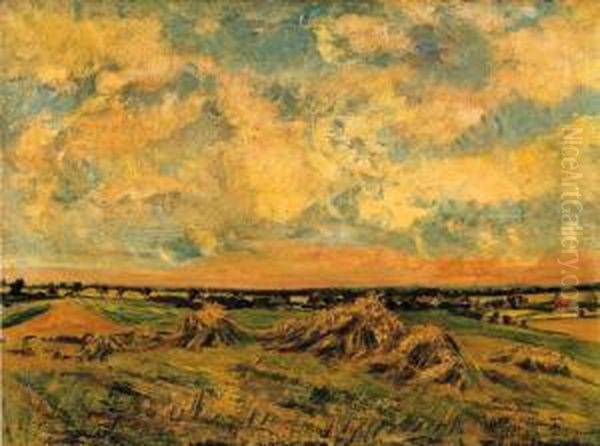
Around 1899, Clark embarked on the next major phase of his artistic education, traveling to Paris, the epicenter of the art world at the time. There, he immersed himself in the vibrant atmosphere that had fostered the Impressionist movement. His most significant mentor during this period was the expatriate American master, James Abbott McNeill Whistler. Studying under Whistler profoundly impacted Clark's understanding of tone, composition, and the subtleties of light, key elements of the Impressionist aesthetic.
Clark's Parisian education was diverse. He also studied with other notable artists, including the academic painter Jean-Paul Laurens, and was exposed to the work of contemporaries like Amedeo Modigliani. This period was crucial for Clark as he absorbed the principles of French Impressionism, particularly its emphasis on capturing fleeting moments, the effects of light and atmosphere, and painting en plein air (outdoors).
While in France, Clark did not work in isolation. He became part of a community of American artists living and working abroad, particularly in Giverny, the home of Claude Monet. He formed working relationships and friendships with fellow painters such as Lawton Parker, Guy Rose, and Frederick Carl Frieseke. His collaboration with Parker was particularly close, resulting in shared artistic explorations, including works like "Giverny Countryside." These interactions further refined his Impressionist technique and solidified his unique artistic voice, blending European influences with his American perspective.
Documenting an Era: The Panama Canal Series
In 1900, Alson Clark married Atta Medora McMillan. The couple would eventually have a son and a daughter. While his family life grew, Clark's artistic ambitions continued to drive him towards significant projects. One of the most remarkable undertakings of his career was his series of paintings documenting the construction of the Panama Canal.
In 1913, Clark secured permission to visit the Canal Zone during the monumental construction effort. This was an unprecedented opportunity to witness and record one of the greatest engineering feats of the modern era. He spent considerable time on site, creating nearly forty paintings that captured the immense scale, human effort, and dramatic landscapes of the canal's creation. These works are not merely artistic representations; they serve as invaluable historical documents.
The Panama Canal series brought Clark significant recognition. The paintings were prominently featured at the Panama-Pacific International Exposition held in San Francisco in 1915. This major world's fair celebrated the canal's completion, and Clark's works offered visitors a vivid, artistic perspective on the project. His contribution was acknowledged with a bronze medal, cementing his reputation as an artist capable of tackling grand, contemporary themes with Impressionist sensibility.
Wartime Service and a Shift to California
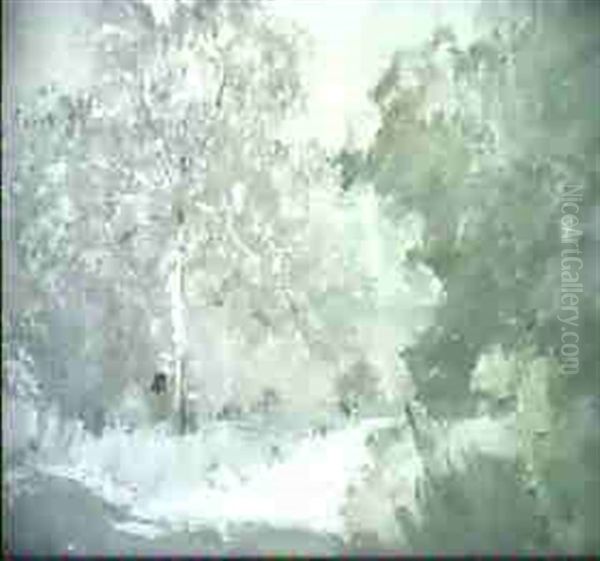
The outbreak of World War I interrupted Clark's artistic career, as it did for many of his generation. He enlisted in the military, serving his country in a unique capacity that utilized his visual acuity: as an aerial reconnaissance photographer. This role placed him in dangerous situations, offering a starkly different perspective on the landscape than his plein-air painting excursions. This experience, capturing images from the air for military intelligence, undoubtedly influenced his perception of form and perspective, even if direct artistic output from this period is less known.
Unfortunately, Clark's military service was cut short due to health problems, leading to his discharge. Following the war, seeking a climate more conducive to his health and new artistic inspiration, Clark made a significant life change. He relocated from the East Coast and Midwest to the burgeoning region of Southern California. He and his family settled in the Pasadena area, a move that would define the later stages of his career and firmly establish him within the California Impressionist movement.
California Impressionism and Later Career
Southern California provided Alson Skinner Clark with a wealth of new subjects and a vibrant, growing art community. The region's unique light, diverse landscapes – from mountains and deserts to the Pacific coast – and distinctive architecture became central themes in his work. He quickly became an active and respected member of the California art scene.
Clark continued to paint prolifically, applying his Impressionist technique to capture the beauty of his new surroundings. Works titled "California Landscape" exemplify this period, showcasing his skill in rendering the bright sunlight and vivid colors characteristic of the region. His established reputation also meant continued interest in works depicting other locales, such as the evocative "Seine at Night, Paris," demonstrating his versatility. Other notable works from his broader career include "The Lock" and "The Violinist," and the intriguingly titled "Catfish Row," showcasing his range of subjects.
Beyond his own painting, Clark made significant contributions to the artistic life of Southern California through education and organizational leadership. He served as the director of the Stickney Memorial School of Art in Pasadena, influencing a new generation of artists. He also held important positions within key arts organizations, most notably the California Art Club, helping to shape the direction and promote the work of regional artists. His commitment extended to public art as well; Clark painted murals for prominent local landmarks, including the Carthay Circle Theatre in Los Angeles and the First Trust & Savings Bank in Pasadena.
Exhibitions, Collections, and Recognition
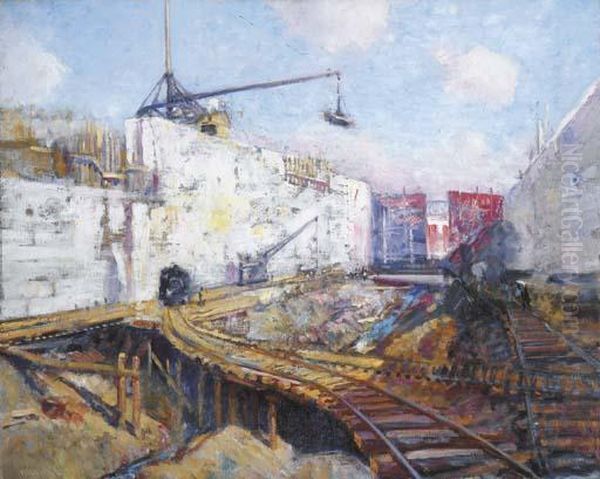
Throughout his career, Alson Skinner Clark's work was consistently exhibited in prestigious venues, reflecting the respect he commanded in the art world. He was a regular participant in exhibitions organized by the California Art Club, including shows documented as recently as 2005, indicating continued interest in his work long after his death. His participation in the 1915 Panama-Pacific International Exposition remained a highlight of his exhibition history. His paintings were also shown at institutions like the Pasadena Art Museum (a predecessor to the Norton Simon Museum).
Clark's paintings were sought after by collectors and institutions alike. His work found its way into numerous private collections, handled by dealers in major art centers like Chicago and New York. Museums recognized the quality and importance of his art; his paintings are included in the permanent collection of the California Art Club and were acquired by the Pasadena Art Museum, among others. His ability to capture both the grandeur of projects like the Panama Canal and the intimate beauty of landscapes ensured his appeal to a wide audience.
His mastery of the plein-air technique, allowing him to capture the immediate sensations of light and atmosphere directly from nature, was particularly admired. This skill, honed in France and applied brilliantly to the diverse landscapes he encountered throughout his life, is a defining characteristic of his enduring appeal.
Legacy and Historical Reappraisal
Alson Skinner Clark passed away on March 23, 1949, shortly after being hospitalized for pneumonia. His death was reportedly sudden, occurring during his recovery. Following his passing, his wife, Medora Clark, played a crucial role in preserving his artistic legacy by organizing his studio and ensuring his works were documented and cared for.
For a period, like some artists of his generation whose work fell between major modernist movements, Clark's name might have been somewhat overlooked in broader art historical narratives. However, with the resurgence of interest in American Impressionism, and particularly in the distinct contributions of the California Impressionists, Clark's reputation has undergone a significant reappraisal.
Today, he is recognized as a key figure in American art of the early 20th century. His Panama Canal series remains a unique artistic and historical achievement. His California landscapes are celebrated for their vibrant light and color, embodying the spirit of the region's Impressionist movement. He is studied alongside other major American Impressionists like Childe Hassam and Edmund C. Tarbell, artists who, like Clark, adapted Impressionist principles to American subjects. His influence extended through his teaching at the Stickney Memorial School of Art and his leadership in organizations like the California Art Club.
Conclusion
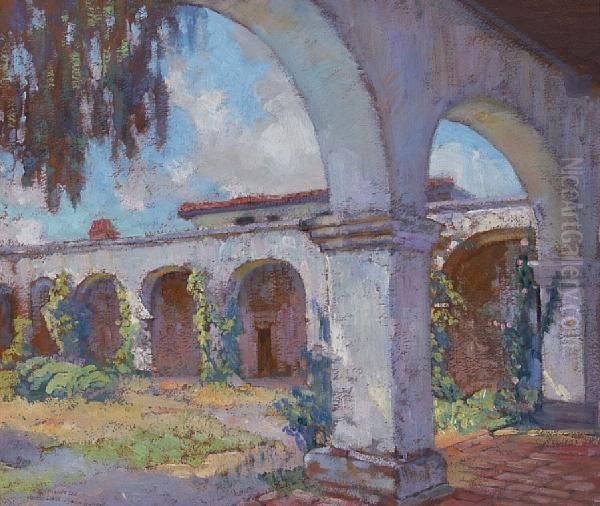
Alson Skinner Clark's life and art trace a fascinating path through the landscapes and artistic currents of his time. From his early studies in Chicago and New York under William Merritt Chase, through his formative years in Paris with James Abbott McNeill Whistler and association with artists like Lawton Parker, Guy Rose, and Frederick Carl Frieseke, to his monumental documentation of the Panama Canal and his final, influential decades in California, Clark consistently produced work characterized by technical skill and a sensitive response to light and place. His legacy endures in his paintings, which continue to be admired for their beauty and historical significance, securing his place as an important American Impressionist painter.